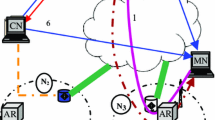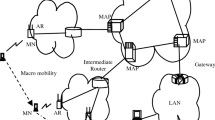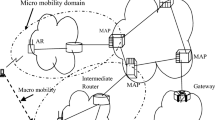Abstract
Hierarchical Mobile IPv6 (HMIPv6) is an enhanced version of Mobile IPv6 designed to reduce signaling overhead and to support seamless handoff in IP-based wireless/mobile networks. To support more scalable services, HMIPv6 networks can be organized as the form of a multi-level hierarchy architecture (i.e., tree structure). However, since multi-level HMIPv6 networks incur additional packet processing overhead at multiple mobility agents, it is important to find the optimal hierarchy level to minimize the total cost, which consists of the location update cost and the packet delivery cost. In this paper, we investigate this problem, namely the design of an optimal multi-level HMIPv6 (OM-HMIPv6) network. To accomplish this, we design a function to represent the location update cost and the packet delivery cost in multi-level HMIPv6 networks. Based on these formulated cost functions, we calculate the optimal hierarchy level in multi-level HMIPv6 networks, in order to minimize the total cost. In addition, we investigate the effects of the session-to-mobility ratio (SMR) on the total cost and the optimal hierarchy. The numerical results, which show various relationships among the network size, optimal hierarchy, and SMR, can be utilized to design an optimal HMIPv6 network. In addition, the analytical results are validated by comprehensive simulations.
Similar content being viewed by others
References
I.F. Akyildiz, et al., “Mobility Management in Next-Generation Wireless Systems”, Proceedings of the IEEE, Vol. 87, No. 8, pp. 1347–1384, 1999.
H. Soliman, C. Castelluccia, K. El-Malki, and L. Bellier, “Hierarchical Mobile IPv6 Mobility Management (HMIPv6)”, Internet Draft, draft-ietf-mipshop-hmipv6-03.txt, October 2004.
E. Gustafsson, A. Jonsson, and C. Perkins, “Mobile IP Regional Registration”, IETF Internet Draft, draft-ietf-mobileip-reg-tunnel-02.txt, March 2000.
Y. Fang, “Movement-Based Mobility Management and Trade Off Analysis for Wireless Mobile Metworks”, IEEE Transactions on Computers, Vol. 52, No. 6, pp. 791–803, 2003.
J. Xie and I.F. Akyildiz, “A Distributed Dynamic Regional Location Management Scheme for Mobile IP”, IEEE Transactions on Mobile Computing, Vol. 1, No. 3, pp. 163–175, 2002.
M. Woo, “Performance Analysis of Mobile IP Regional Registration”, IEICE Transactions on Communications, Vol. E86-B, No. 2, pp. 472–477, 2003.
S. Pack and Y. Choi, “A Study on Performance of Hierarchical Mobile IPv6 in IP-Based Cellular Networks”, IEICE Transactions on Communications, Vol. E87-B, No. 3, pp. 462–469, 2004.
W. Ma and Y. Fang, “Dynamic Hierarchical Mobility Management Strategy for Mobile IP Networks”, IEEE Journal on Selected Areas in Communications, Vol. 22, No. 4, pp. 664–676, May 2004.
H. Omar, T. Saadawi, and M. Lee, “Supporting Reduced Location Management Overhead and Fault Tolerance in Mobile-IP Systems”, in Proc. IEEE ISCC 1999, July 1999.
Y. Xu, H.C.J. Lee, and V.L.L. Thing, “A Local Mobility Agent Selection Algorithm for Mobile Networks”, in Proc. IEEE ICC 2003, May 2003.
D. Johnson, C. Perkins, and J. Arkko, “Mobility Support in IPv6”, IETF RFC 3775, June 2003.
X. Zhang, J. Castellanos, and A. Capbell, “P-MIP: Paging Extensions for Mobile IP”, ACM Mobile Networks and Applications, Vol. 7, No. 2, pp. 127–141, 2002.
F. Baumann and I. Niemegeers, “An Evaluation of Location Management Procedures”, in Proc. IEEE ICUPC 1994, 1994.
T. Brown and S. Mohan, “Mobility Management for Personal Communications Systems”, IEEE Transaction on Vehicular Technology, Vol. 46, No. 2, pp. 269–278, 1997.
D. Schwab and R. Bunt, “Characterising the Use of a Campus Wireless Network”, in Proc. IEEE INFOCOM, March 2004.
F. Chinchilla, M. Lindsey, and M. Papadopouli, “Analysis of Wireless Information Locality and Association Patterns in a Campus”, in Proc. IEEE INFOCOM, March 2004.
S. Pack, T. Kwon, and Y. Choi, “A Comparative Study of Mobility Anchor Point Selection Schemes in Hierarchical Mobile IPv6 Networks”, in Proc. ACM MobiWac, September 2004.
T. Camp, J. Bolen, and V. Davis, “A Survey of Mobility Models for Ad-hoc Network Research”, Wireless Communication and Mobile Computing, Vol. 2, No. 5, pp. 483–502, 2002.
H. Zeng, Y. Fang, and I. Chlamtac, “Call Blockign Perfromance Study for PCS Networks under More Realistic Mobility Assumptions”, Telecommunication Systems, Vol. 19, No. 2, pp. 125–146, 2002.
D. Gross and C. Harris, Fundamentals of Queuing Theory, John Wiley & Sons, Third edn. 1998.
Author information
Authors and Affiliations
Corresponding author
Additional information
Sangheon Pack received his B.S. (2000, magna cum laude) and Ph.D. (2005) degrees from Seoul National University, both in computer engineering. He is a post doctor fellow in the School of Computer Science and Engineering at the Seoul National University, Korea. He is a member of the IEEE and ACM. During 2002–2005, he was a recipient of the Korea Foundation for Advanced Studies (KFAS) Computer Science and Information Technology Scholarship. He has been also a member of Samsung Frontier Membership (SFM) from 1999. He received a student travel grant award for the IFIP Personal Wireless Conference (PWC) 2003. He was a visiting researcher to Fraunhofer FOKUS, German in 2003. His research interests include mobility management, wireless multimedia transmission, and QoS provision issues in the next-generation wireless/mobile networks.
Yanghee Choi received B.S. in electronics engineering from Seoul National University, M.S. in electrical engineering from Korea advanced Institute of Science, and Doctor of Engineering in Computer Science from Ecole Nationale Superieure des Telecommunications (ENST) in Paris, in 1975, 1977 and 1984 respectively. Before joining the School of Computer Engineering, Seoul National University in 1991, he has been with Electronics and Telecommunications Research Institute (ETRI) during 1977–1991, where he served as director of Data Communication Section, and Protocol Engineering Center. He was research student at Centre National d'Etude des Telecommunications (CNET), Issy-les-Moulineaux, during 1981–1984. He was also Visiting Scientist to IBM T.J. Watson Research Center for the year 1988–1989. He is now leading the Multimedia Communications Laboratory in Seoul National University. He is also director of Computer Network Research Center in Institute of Computer Technology (ICT). He was editor-in-chief of Korea Information Science Society journals. He was chairman of the Special Interest Group on Information Networking. He has been associate dean of research affairs at Seoul National University. He was president of Open Systems and Internet Association of Korea. His research interest lies in the field of multimedia systems and high-speed networking.
Minji Nam received her B.S. and M.S degrees in Computer Science and Engineering from Seoul National University in 2003 and 2005, respectively. From 2005, she has worked on Portable Internet Development Team for Korea Telecom. Her research interests are mobile networks, portable internet technology (IEEE 802.16) and Mobile IPv6.
Rights and permissions
About this article
Cite this article
Pack, S., Choi, Y. & Nam, M. Design and Analysis of Optimal Multi-Level Hierarchical Mobile IPv6 Networks. Wireless Pers Commun 36, 95–112 (2006). https://doi.org/10.1007/s11277-006-0025-7
Issue Date:
DOI: https://doi.org/10.1007/s11277-006-0025-7




